.
I haven't posted much in the past week, but you'd be well advised to recognize the fact that I'm about to make up for it in a BIG way, and by that I mean "I'm about to create the single longest blog posting in the history of western civilization - I sincerely doubt that you'll get through even half of it before you asphyxiate upon your own boredom-induced vomit." Curse the name Enron McHanslaw all you want my friends, attentive ears will hear only gurgling.
Wow, that was a touch over the line. When did this blog become so unapologetically gothic and brooding? My heavens, I hope this doesn't mean I have to start listening to Cannibal Corpse... that's really not something I'm prepared to handle.
Moving on...
Welcome to part 2 of 3 or 4 of my series on repurposing old speakers into furniture-like objects. In this entry, I'll be turning a giant floor mounted speaker into a media cabinet, which in my mind is really the most logical thing you could do with a speaker. The pictures I have available alone should make this entry a good 14 pages long, so I'll try to keep the banter to a minimum from here on out. I'll fail, but please just note that I did try.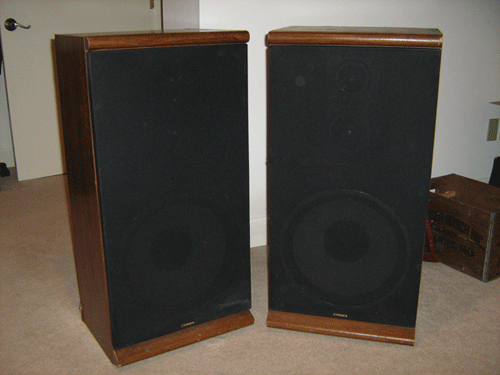
Much like the last speakers I worked with, these beauties weren't much to behold upon first glance, but once you rid them of their oppressive screen coverings, their stock (which was tied to their sexiness) literally shot directly through the roof. An immigrant laying shingles on said roof was heard to exclaim, "ouch my ass, something sexy just penetrated my ass." His English as a Second Language professor at the local community college was overjoyed to hear of his feats of proper grammar and conjugation.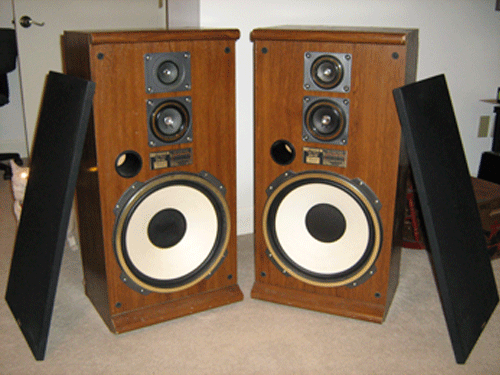
I've been told by someone who used to sell Hi-Fi equipment that this style of speaker (giant cone woofer with tiny secondary speakers) was really popular in the late 70's, but fell out of favor shortly thereafter when the public realized that that all of these speakers produced dreadful sound. I said to this man, "that's interesting." I try not to lie, but under certain circumstances it's the only choice I have available.
I bought these for $20 off some 18 year old Hispanic kid who was living in his girlfriend's grandparents' basement and had a giant Famous Stars and Straps logo tattooed on one of his hands (he had the Virgin Mary inked on his other arm, but I wasn't able to get a close enough look to tell whether or not she was sporting a pair of Lugz). Actually, he seemed like a pretty cool kid, though he absolutely lied to me about these speakers, so I've got to dock him a few points for that maneuver (I'll get to that later).
One of the speakers featured a really clean outer case, but its speakers were aesthetically kind of beat up, while the other had a beat up outer case with aesthetically pleasing speakers. I had two projects in mind for these bad boys, one which I knew I wouldn't screw up on (that will be part 3 of this spectacular series, in case you're wondering) and one which I was almost certain I would screw up on (that would be this entry that you're currently reading). As such, I decided to put the crummy speakers with the crummy outer case and use them for this project, while leaving the purty stuff for my next foray into crap manipulation.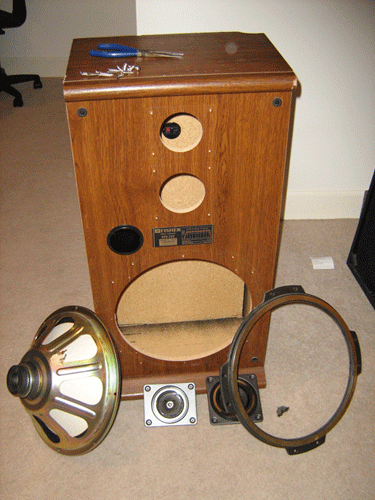
I started things off by removing all of the speakers from the outer case and ripping out all of the wires that they were connected to. This was when I realized that my Latino friend had fed me a hefty fib, as he'd claimed repeatedly that both of the speakers worked great, though upon closer inspection I found that inside one of the speakers almost none of the wires were connected to anything other than a small pile of dust at the bottom of the outer case. If this speaker had been working at all, it could have only been via an act of divine intervention, and if that were truly the case I sincerely need to have a sit down chat with Jesus Harold Christ about how to choose his battles. There are quite honestly several starving people in the Sudan whose lives are worth more than the continued functionality of this antiquated speaker. I'm not even kidding.
Once that was taken care of, I set myself to get the magnets off of the backs of my dislodged speakers, as they weigh a ton and would wreak havoc on the DVDs and video games I intended to enclose in my eventual media cabinet. I talked about this process in my last speaker-based project, but I didn't provide any pictures. Well, here's some pictures: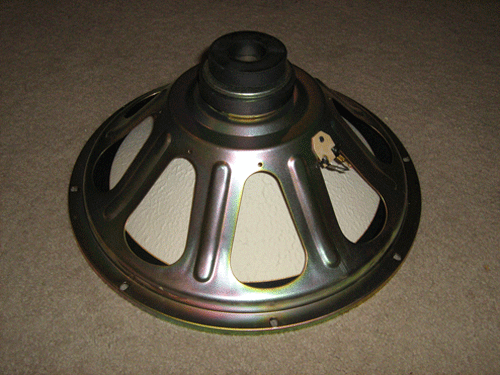
This particular speaker actually has 2 magnets on it, one of which is the donut looking object at the top of the image, and the other is the black and metallic disk that lies right beneath it. After popping these off with a chisel, you're left with a situation that looks something like-a this: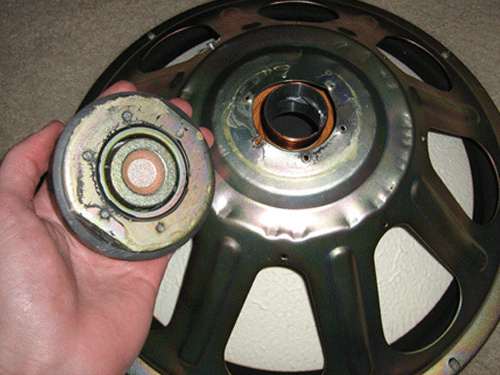
These magnetic discs aren't really held on by much (note the short pins on the disc and the ring of glue residue on the back of the speaker), but this one was tougher to remove than most. As you can tell from the circle of dents surrounding the ring where the magnets used to be, I had to lay into this thing with a crowbar pretty heavily before it would come off, but I did eventually triumph over this inanimate object. Let this be a lesson to you kids out there: There is no problem in this world that cannot be solved by the proper use of a crowbar.
For my last speaker project, all I really had to do to turn a speaker box into a trunk was cut it in half, but this project was considerably more complicated on a fundamental level as I needed to cut a door out of the speaker box that would not come in contact with the ground (this would make opening and closing the cabinet an extremely clumsy chore, if not entirely impractical). I'm sure there are better ways to do this than what I ended up doing, but this was the only method I could come up with: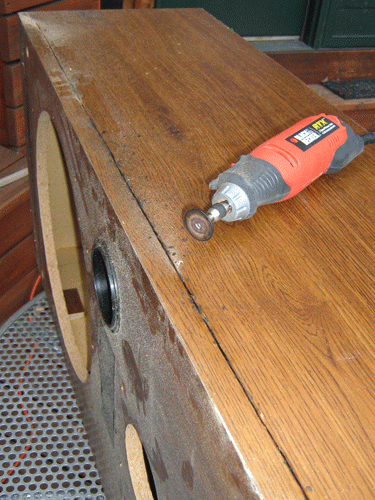
Now that's a picture that requires explanation if I've ever seen one. After doing all of my measuring and lining out of the cuts that I wanted to make, I took a rotary tool and cut a trench along my lines with some medium-strength cutting discs (pictured above). This process was tedious to say the least, as the cutting discs would crap out or break after about 10 inches of cutting (I probably went through about 13 or 14 of them, though they're only worth about 2 cents apiece), but it got the job done. Also, the discs seemed to burn their way through the wood more than they actually cut it, so all sorts of psychedelic 70's particle board fumes were floating around and what not... it was pretty intense.
After all of my lines and measurements had been turned into deep grooves, I just took a hand held miter saw and finished all of the cuts that my rotary tool had begun. This probably sounds like a bit of a chore, but it actually went by pretty quickly - once I was able to dig through the outer case in one tiny spot with the end of the saw, the rest of that cut was a snap. What I ended up with was this delicious insanity:
If you look carefully, you can see the little half circle burn marks from the rotary tool on the edges of the main box. If you don't look carefully at all, you can see some sort of object made out of something that looks like wood. This is your adventure young Padawan, and yours alone - choose your path wisely (this sentence is exactly why I need to start forcibly putting myself to bed at 12am, nothing good ever gets posted to the internet after midnight).
After figuring out the layout of media storage I wanted to have inside my cabinet, I sanded down the gnarled edges of my cuts as well as the inside of the box, then covered the whole inside surface and my shelf boards with a layer of semi-gloss paint. Once that dried, I secured my shelves into place using L brackets and epoxy putty (normally I would have just screwed in the L brackets, but the screws that came with my brackets were about twice as long as the board they would have been drilled through... not exactly the look I was going for).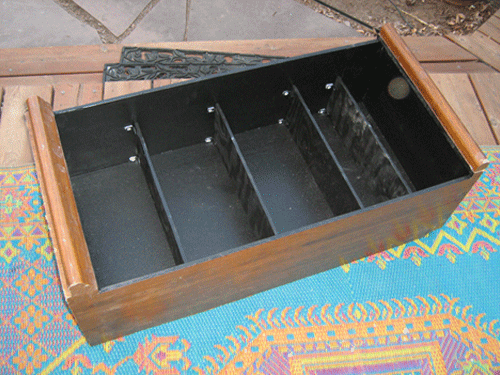
I put on a second coat of paint, then screwed on some hinges and a handle that I'd picked up at my neighborhood Home Despot. Just to homogenize the inside look of the finished product a bit, I also spray painted the back of my speakers black so they'd match the rest of the door. After that, it was just a matter of screwing the speakers back into their original positions, then cramming all of my crap into this mightily attractive receptacle. Without further adieu, the final results...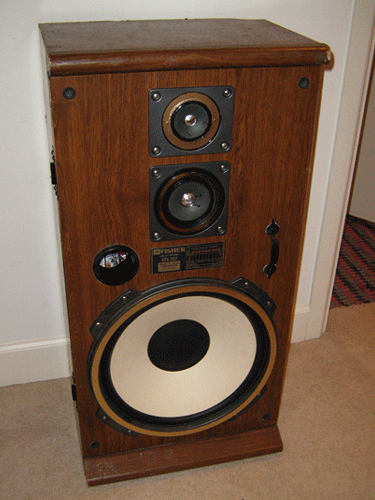
Bam.
Bang!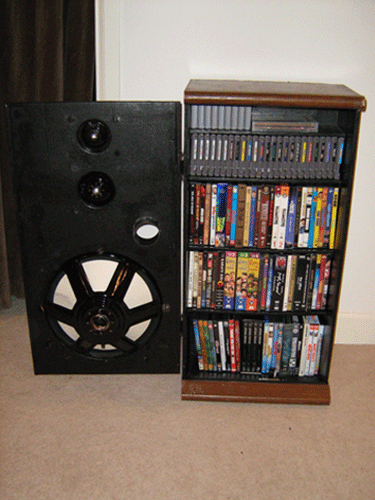
KABOOM!!!
Though you're likely too blinded with awe to notice such things, this piece is still in need of some significant TLC before it can be considered truly finished (as you can see in the second picture above one of the top corners has a huge chunk missing from it, and I'd like to plug up that plastic pipe with something so you can't see what's inside just by looking at the cabinet), but that stuff can come later.
I'm thinking about building a larger cabinet to surround this one, so that I can have all of my A/V junk in one place, but I've never built a set of shelves from scratch before, so that'll probably take me a fairly long while to get planned out, let alone to actually build it. For now, I'll just stick with the speaker-based media cabinet that I've got before me and call it good. Scratch that, I'll call it better than good, I'll call it Lothario. I've always admired that name. It's a handsome name.
Welp, that's it for now. Be sure to tune in next time when I'll show you how to turn your navel lint into a personal lubricant.
Tuesday, March 4, 2008
REPURPOSING: THE SPEAKER CHRONICLES, PART 2 OF 3 OR 4
Labels: Repurposing, Speaker Mods
Subscribe to:
Post Comments (Atom)





2 comments:
I have to admit to being impressed. I had no idea you were even vaguely handy, and now you're making stuff out of crap. Good show.
The thing you're writing is a big blunder.
Post a Comment